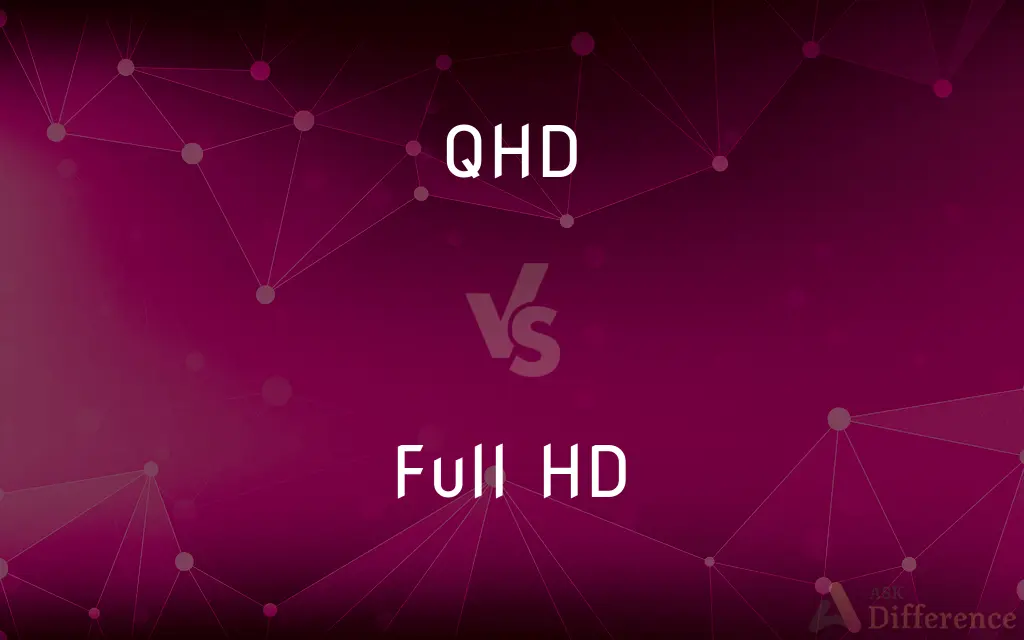QHD vs. Full HD — What's the Difference?
By Tayyaba Rehman — Published on November 18, 2023
QHD stands for Quad High Definition with a resolution of 2560 x 1440 pixels, while Full HD refers to Full High Definition with a 1920 x 1080 pixel resolution.

Difference Between QHD and Full HD
Table of Contents
ADVERTISEMENT
Key Differences
QHD, or Quad High Definition, represents a display resolution of 2560 x 1440 pixels. This term comes from the fact that QHD is four times the resolution of standard HD (1280 x 720). On the other hand, Full HD, often simply termed as FHD, boasts a resolution of 1920 x 1080 pixels. This is double the resolution of standard HD, which is why it's termed "full".
When considering clarity and detail, QHD screens have a clear edge over Full HD ones. Given that QHD displays have a higher pixel density, they can show more detailed images. Full HD screens, while offering good clarity and detail, may not provide the same sharpness that QHD displays offer, especially on larger screens.
From a content perspective, Full HD content is more abundant. Many streaming services, TV broadcasts, and physical media are available in Full HD. QHD content, while growing in availability, is still less common in comparison. This means users with QHD displays might often watch content in resolutions less than their display's capability.
While both QHD and Full HD offer excellent viewing experiences, they cater to different needs and budgets. Devices with QHD displays tend to be pricier due to the advanced technology needed to support higher resolutions. Full HD, being a more established standard, is found in a broader range of devices and price points.
Comparison Chart
Resolution
2560 x 1440 pixels
1920 x 1080 pixels
ADVERTISEMENT
Pixel Density
Higher (more detailed images)
Lower (less detailed images)
Content Availability
Less common
More common
Terminology Origin
Four times standard HD
Double of standard HD
Price Point
Generally higher
More varied and often lower
Compare with Definitions
QHD
QHD offers more detailed imagery due to higher pixel density.
Photographers prefer QHD screens to accurately edit their high-resolution photos.
Full HD
Full HD represents a display resolution of 1920 x 1080 pixels.
Most mainstream laptops come with a Full HD screen.
QHD
QHD is less common in content compared to Full HD.
Despite having a QHD TV, most of the shows Jenny watches are in Full HD.
Full HD
Full HD is also known as FHD, signifying Full High Definition.
Blu-ray discs often deliver movies in Full HD quality.
QHD
QHD is a display resolution of 2560 x 1440 pixels.
The latest gaming monitor boasts a QHD display for sharper visuals.
Full HD
Full HD content is abundantly available across platforms.
On his Full HD TV, Kevin has a vast choice of content from various streaming services.
QHD
QHD screens are often found in high-end devices.
The premium smartphone features a QHD display for better video playback.
Full HD
Full HD provides clearer visuals than standard HD.
Upgrading to a Full HD TV from a standard HD one made a significant difference in viewing experience.
QHD
QHD stands for Quad High Definition.
QHD gets its name as it's four times the resolution of standard HD.
Full HD
Full HD is a widely adopted resolution standard.
The webinar was streamed in Full HD, ensuring clear visuals for all attendees.
Common Curiosities
Which offers better image clarity: QHD or Full HD?
QHD offers better clarity due to a higher pixel density.
What does QHD stand for?
QHD stands for Quad High Definition.
How does Full HD differ from standard HD?
Full HD has a resolution of 1920 x 1080, double that of standard HD (1280 x 720).
Is there a noticeable difference between QHD and Full HD on smaller screens?
On smaller screens, the difference may be less pronounced. The distinction becomes clearer on larger displays.
Are there specific applications where QHD is preferred over Full HD?
Yes, tasks like graphic design, professional photo editing, and gaming can benefit from QHD's higher resolution.
Can I view Full HD content on a QHD display?
Yes, Full HD content can be viewed on a QHD display, though it might not utilize the screen's full resolution.
Are QHD devices generally more expensive than Full HD ones?
Yes, QHD devices typically come at a higher price point due to the advanced display technology.
Do streaming services offer QHD content?
Some streaming services offer QHD content, but Full HD remains more prevalent.
Is QHD content widely available like Full HD?
While QHD content is growing, Full HD content is currently more abundant.
Is battery consumption different between QHD and Full HD devices?
QHD screens might consume more battery than Full HD screens due to the higher pixel count.
Can I change my device's resolution from QHD to Full HD?
Some devices allow users to switch resolutions to save battery life or enhance performance.
Why is QHD termed "Quad" High Definition?
It's called "Quad" because it has four times the resolution of standard HD (1280 x 720).
Is it worth upgrading from Full HD to QHD for casual use?
For general use, Full HD might suffice. However, if you seek sharper visuals or work in fields requiring high-resolution displays, a QHD upgrade could be beneficial.
Are all new devices moving to QHD resolutions?
Not necessarily. While many high-end devices feature QHD, Full HD remains popular due to its balance of quality and cost.
Does a QHD screen mean better overall display quality than Full HD?
While QHD offers higher resolution, other factors like color accuracy, brightness, and contrast also affect display quality.
Share Your Discovery

Previous Comparison
Oatmeal vs. Cream of Wheat
Next Comparison
Windows 7 vs. Windows 10Author Spotlight
Written by
Tayyaba RehmanTayyaba Rehman is a distinguished writer, currently serving as a primary contributor to askdifference.com. As a researcher in semantics and etymology, Tayyaba's passion for the complexity of languages and their distinctions has found a perfect home on the platform. Tayyaba delves into the intricacies of language, distinguishing between commonly confused words and phrases, thereby providing clarity for readers worldwide.












































